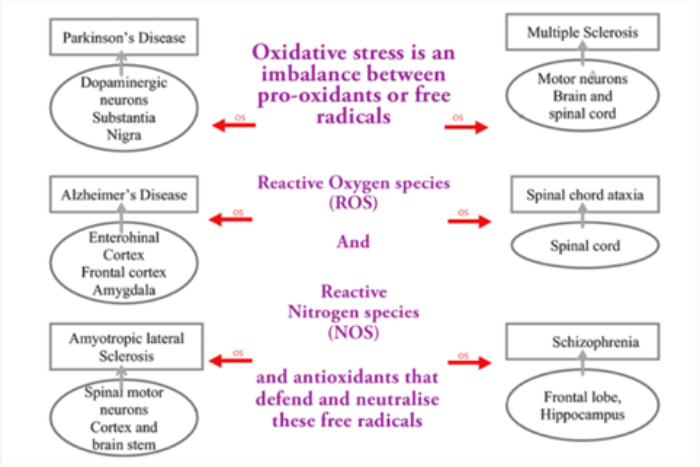The effects of oxidative stress on the central nervous system
The central nervous system, comprising the brain and spinal cord, is our body’s control and processing house. It is vital to maintain the brain’s biochemical stability for the normal functioning of the CNS and to prevent neurological disorders. Trauma, infections, tumours, blood flow disruption, etc. are some of the main causes of neurological diseases. One of the most crucial underlying factors for these causes is cerebral oxidative stress. A disturbance or impairment in the cerebral biochemical situation results in cerebral oxidative stress.
One of our previous articles explores the impact of oxidative stress on the female reproductive system. Today, our experts at Helvetica Health Care (HHC) delve into the importance of cerebral oxidative stress to the impairment of the central nervous system, thus leading to various neurological disorders.
Given that OS affects many aspects of public health and life, supplying products like high-grade OS assay kits and standards which help labs explore OS markers has been one of our top priorities at HHC. We supply labs with our range of OXIDATIVE STRESS assay kits and standards, designed to assist in the exploration of oxidative stress markers and metabolites in human and animal samples as well as samples exposed to drugs and foods.
What is Oxidative Stress?
Oxidative stress is an imbalance between pro-oxidants or free radicals — Reactive Oxygen species (ROS) and Reactive Nitrogen species (NOS) — and antioxidants that defend and neutralise these free radicals.
In other words, oxidative stress or OS is a disturbance in the biological equilibrium at the intracellular level. It is a chemical process wherein the excessive formation of free radicals results from the insufficient amount and counteractivity of antioxidant response.
What are the effects of oxidative stress on the central nervous system?
Oxygen is essential to all life and life processes, especially to the CNS. The CNS consumes copious amounts of oxygen to perform various bodily functions. During this process of aerobic metabolism, many free radicals or ROS are generated, which are neutralised by antioxidants. This allows the brain to effectively regulate its oxygen consumption and its capacity for redox generation. Certain factors make CNS prone to ROS invasion, the first being insufficient antioxidant response system, blood-brain barrier selectivity and high concentration of polyunsaturated fatty acids, which restricts the distribution of several antioxidants, such as vitamin E.
In excess of ROS production with a low neutralising or scavenging capacity of the antioxidant response system, there is significant protein oxidation and lipid peroxidation, leading to oxidative abuse, cellular ageing, and even functional impairment. The brain’s high lipid composition and huge energy demand, accompanied by the weak antioxidant response system, make it very susceptible to oxidative abuse. Any damage to the brain due to oxidative stress can negatively impact regular CNS functions.
Moreover, the brain’s phospholipids are particularly susceptible to ROS-mediated peroxidation. Oxidative DNA damage and protein damage during the ageing process are even more significant. According to research, oxidative stress-related mitochondrial DNA mutations are more common in older brains. As a result, ROS accumulation is a biological hazard that can seriously harm neurons and damage brain tissue if it outpaces or circumvents protective processes.
It is important to note that oxidative stress is frequently referred to as a self-replicating process. When oxidative stress-induced excessive ROS emission causes cellular damage, the damaged macromolecules may act as and/or develop into ROS.
Although the exact mechanism by which ROS injure cerebral tissue is unknown, ROS may activate several molecular reactions that alter brain shape and increase blood-brain barrier permeability, leading to neuroinflammation and neuronal death.
Oxidative stress and neurological diseases
Is directly linked to the development of CNS pathologies. Oxidative stress has been detected in the early stages of neurodegenerative diseases such as Alzheimer’s, Parkinson’s, Huntington’s, amyotrophic lateral sclerosis, demyelinating diseases, cerebrovascular disorders, and psychiatric disorders such as anxiety and depression. All of these suggest that free radicals may be a factor in their aetiologies.
Recent research on autism spectrum disorders indicate that an imbalance between oxidative species and antioxidants can contribute to the pathophysiology of these disorders. The participants of a study (children) displayed altered oxidative stress indicators, alterations in membrane fluidity, and cerebellar neuronal death.
Oxidative stress has also been associated with neuronal hyperexcitability. Studies show the function of ROS in epilepsy and drug-resistant epilepsy. Epileptic episodes cause cellular macromolecule oxidation to increase before neuronal death occurs.
That’s not all. Because oxidative stress can also cause disruptions in normal mechanisms of cellular signalling, it is also believed to be involved in the development of other diseases, including Asperger syndrome, Schizophrenia, ADHD, cancer, heart failure, myocardial infarction, fragile X syndrome, Sickle Cell Disease, lichen planus, vitiligo, infection and chronic fatigue syndrome.
There is not much doubt that oxidative stress can have serious consequences on people’s mental and physical well-being. Tracing the causes of neurological diseases requires high-grade testing and lab applications. To improve the output of laboratories, HHC strives to provide authentic and specialised TBARS (Thiobarbituric Acid Reactive Substances) assay, which has become the assay of choice for screening and monitoring lipid peroxidation, a major indicator of oxidative stress. The assay can be used with many types of samples, including drugs, food products and materials of human and animal origin and provides standardised and reproducible results.
Let us know if you would like to source our products to enhance your lab testing and research capabilities further. Call us now!Evidence acquired through research and studies suggests that increased brain oxidative damage

